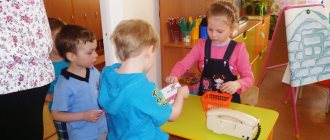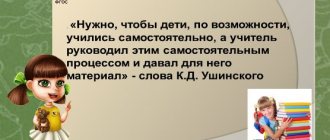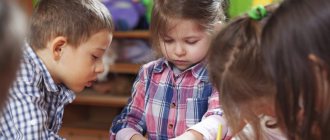Summary of a lesson in a preparatory group for children with special needs on developing communication skills
Summary of a lesson in a preparatory school group for children with severe speech impairments on the formation of communication skills.
Topic: “Seven-flowered flower” The lesson is relevant for teachers of groups of children with severe speech impairments. Goal : to develop communication skills in children with severe speech impairments in the process of learning coherent storytelling. Objectives : 1) Strengthen the ability to construct a grammatically correct statement. 2) Develop the ability to communicate through facial expressions, gestures, pantomime and expressive language. 3) Cultivate a friendly attitude towards each other, the ability to listen to comrades and, if necessary, come to the rescue. Equipment : manual “Flower of Seven Flowers”, life-size puppets of a wolf and a fox, a set of fruits and vegetables, notices of missing pets issued by children, cards with numbers from 1 to 4 (4 sets). Preliminary work: learning the sketch “The Wolf and the Fox” by S.Ya.
Marshak, creative task with parents “Announcement of a missing pet.” Progress of the lesson
Organizational moment. (Children are part of a group. A multi-colored flower is laid out on the flannelgraph) Speech therapist: Guys, good morning! Children : Hello! Speech therapist : Guys, look at what an unusual flower has bloomed in our group. This is a seven-flowered flower. Why is it called that? Children : Because it has seven colorful petals. Speech therapist : That's right, guys! Our flower is not simple, but magical! By plucking one petal, you can ask for a wish to be granted. Let's use its magic. (One child picks a petal.)
In chorus: Fly, fly petal.
Through the west - to the east, through the north, through the south, return, making a circle. As soon as you touch the ground, do it our way! Speech therapist : Order that we end up at the North Pole! Guys, look how snowy and cold it is here. How can we keep warm? Let's greet each other holding hands. Children : Good morning! -Good health! -Peace to your home! (Children’s answer options: I’m very glad to see you! You’re pleasantly surprised here! I’m very glad to meet you! Greetings! Hello! Salute to you! Good morning!). Speech therapist : Greetings from kindergarten! Believe me, I'm always glad to see you! Guys, did you feel the warmth? Where does this warmth come from? Child : From our kind hearts! Child : From our cheerful eyes. Child : From our friendly greetings. Etc. Speech therapist : Well done, guys! And we are waiting for another petal! (The child picks the next petal.) In chorus : Fly, fly petal. Through the west - to the east, through the north, through the south, return, making a circle. As soon as you touch the ground, do it our way! Speech therapist : Tell us to end up on the island of compliments. On this island, everyone is attentive to each other and gives their comrades beautiful words of compliments. (Children line up in 2 lines - girls and boys). Girls : Boys, you are cute. Boys, you are strong. Boys, you are gallant. Boys, you are athletic. Etc. Boys: Girls, you are the cutest among us. Girls, you are the most danceable among us. Girls, you are the most attentive among us. Girls, you are the smartest among us. Etc. Speech therapist : Guys, let me give you compliments too. You Sami are cheerful and the best! (The child picks the next petal.) In chorus : Fly, fly petal. Through the west - to the east, through the north, through the south, return, making a circle. As soon as you touch the ground, do it our way! Speech therapist : Order us to be in the theater! Guys, take your seats. (Children sit on chairs) Speech therapist : Guys, do you know who performs in the theater? Children : Actors perform in the theater. Speech therapist : Right. I invite you to watch the sketch “The Ox and the Fox.” (Children line up in 2 columns, the first children in the columns have life-size puppets of a wolf and a fox in their hands. After each response, the doll is passed to the next one on command. Task: to convey the intonation of a wolf (boys) and a fox (girls) with a voice. Author (speech therapist): gray A wolf in a deep forest met a red fox. Children : - Lizaveta, hello! - How are you, toothy? - Things are going well, your head is still intact! - Where were you? - At the market. - What did you buy? - Pork. - What did you give? - A tuft of fur, they tore off the right side. The tail was chewed off in a fight. - Who bit it off? - Dogs! - Is he alive, dear kumanek? - I barely managed to drag my legs! - How are you doing, fox? - I was at the market. - Why are you doing this? tired? - I was counting ducks. - how many were there? - Seven from eight. - how many became? - Not a single one! - Where are these ducks? - In my stomach! (Then the scene is played out with a change of roles: girls voice the wolf, boys - fox) Speech therapist : What wonderful artists! The fourth petal is waiting for us. (The child picks off the next petal). In chorus : Fly, fly petal. Through the west - to the east, through the north, through the south, come back, making a circle. As soon as you touch the ground, do it our way! Speech therapist : Order us to go to the land of the gnomes. Here we will relax! (Children stand in pairs)
Physical exercise
I am a gnome, you are a gnome. (Children point a finger at themselves, at a friend) I have a house, you have a house. (“Roof” with your hands over yourself, over your friend) I have scarlet cheeks, you have scarlet cheeks. (Rubs his cheeks for himself, a comrade) I have black eyebrows, you have black eyebrows. (“They draw” eyebrows for themselves, a comrade). I have a nose, you have a nose. (Point to your nose, to your friend’s nose). I am a friend, you are a friend. (Children point a finger at themselves, at a friend) Together we are friends! (Children hug) Speech therapist : The next petal awaits us! (The child picks the next petal.) In chorus : Fly, fly petal. Through the west - to the east, through the north, through the south, return, making a circle. As soon as you touch the ground, do it our way! Speech therapist : Command us to enter the kingdom of tastes! But first we need to break into teams using numbers. (Children take numbers from the table. They sit in 4 teams: 1, 2, 3, 4). Speech therapist : Guys, the task of each team is to hold hands and prepare juice in a juicer. And with your face you need to depict what the juice tastes like. (Each team takes turns approaching the table and, after consulting, chooses a fruit or vegetable. Then, holding hands (“juicer effect”),
they show the taste of the juice with facial expressions. Orange is sweet, lemon is sour, onion is bitter).
Speech therapist : Well done guys! The next petal awaits us! The child picks the next petal.) In chorus : Fly, fly petal. Through the west - to the east, through the north, through the south, return, making a circle. As soon as you touch the ground, do it our way! Speech therapist : Tell us to go to the island of good deeds. Guys, you and your parents issued notices about a missing pet. I suggest imagining that you are on television making your announcement. (Children take turns coming out and telling their announcement about a missing kitten or puppy, holding the announcement in their hands).
Speech therapist: Guys, you spoke in great detail about the missing animals.
I really hope they will be found! Well, here is the last petal left! The child picks the next petal.) In chorus : Fly, fly petal. Through the west - to the east, through the north, through the south, return, making a circle. As soon as you touch the ground, do it our way! Speech therapist : Guys, the last petal is a surprise petal. To find this surprise, you need to find an item in the group that was not there before. (Children disperse into the group and find a box with a surprise). Speech therapist : Guys, in the box is Valentin Kataev’s book “The Seven-Flower Flower.” It will add to our group library. Result Speech therapist : Guys, did you enjoy traveling? Children : Yes! Speech therapist : What do you remember about our journey? Child : I remember how I performed in the theater. Child : I liked releasing the necessary announcements. (Children's answers are heard) Speech therapist : Guys, thank you for this exciting journey! Goodbye!
We recommend watching:
Abstract of the educational activity on the topic: Winter for children of the preparatory group. Synopsis of a lesson in the senior group of a kindergarten for children with special needs. Synopsis of a developmental neuropsychological lesson in kindergarten in the junior group. A comprehensive lesson on speech development in the preparatory group with special needs "Journey to the Island of Knowledge"
Similar articles:
Summary of the lesson “Take care of nature” in the preparatory group
Features of the culture of communication among children in the preparatory group for school
The article presents the results of a study of the characteristics and level of development of the culture of communication in children of the preparatory group for school.
Key words: culture of communication, rules of communication, speech etiquette, preschool age.
The problem of developing a culture of communication in preschool children today is one of the most pressing. This is due to the fact that modern society requires the education of a generation that takes an active position, shows independence, masters the culture of communication, and the rules of interaction accepted in society.
The purpose of the study was to study the characteristics and levels of development of a culture of communication in children of the preparatory group for school.
The tasks were:
- Define research criteria and methods.
- Develop criteria and study plans for educational work with children.
- Conduct diagnostics and distribute children according to the levels of development of communication culture and highlight its features.
- Analyze the results.
The study was conducted on the basis of preschool educational institution No. 229 of JSC Russian Railways, Republic of Buritia, Babushkin, Kabansky district. The study involved two groups of children of senior preschool age, 25 people each.
Diagnostic methods were:
- Studying plans for educational work with children.
Purpose: to study the organization of work by educators to develop a culture of communication in children 6–7 years old.
To diagnose the communication culture of children aged 6–7 years, we used the complex methodology of T.V. Senko, consisting of a number of tasks:
- Exercise.
Goal: to identify the general understanding of older preschoolers about the rules of communication and politeness.
- Exercise.
Goal: to identify whether there are speech etiquette formulas in the passive dictionary of older preschoolers, whether they understand them, and whether they use them in their own speech adequately to the communication situation.
- Exercise.
Purpose: to determine the level of development of the ability of older preschoolers to select a speech etiquette formula that is adequate to the situation.
- Exercise.
Goal: to identify the level of development of the ability to control one’s behavior and speech in accordance with the norms of speech culture, to listen and hear the interlocutor and the attitude towards the unethical expressions of the interlocutor [2].
Analysis of plans for educational work showed that teachers, both in the control and experimental groups, do not set special tasks related to the formation of a culture of communication in children.
Irregularly, teachers use various methods and techniques that contribute to the formation of a culture of communication: work with fiction, exercises, games, role-playing games.
The control group also included works of fiction that promote the development of a culture of communication, sketches, and dramatization games. The use of these methods and techniques of work was aimed at developing a culture of behavior for children in general; the culture of communication was not highlighted in the plans of educational work. There is no variety of work forms.
The frequency of activities to develop a culture of communication in educational plans was approximately once every two weeks.
Among the events with parents aimed at developing a culture of communication, one can only note the design of poster information about the education of politeness and the rules of etiquette for children. No other forms were identified in the plans.
Thus, we can conclude that targeted work on developing a culture of communication in these groups is not being carried out.
Using task No. 1, we assessed the level of development of 6–7 year old children’s ideas about the rules of communication and politeness.
We classified 16% in the experimental group and 20% in the control group as having a high level of formed ideas about the rules of communication and politeness. Children aged 6–7 years were classified at this level because they were able to give complete, detailed answers to questions, reveal their understanding of politeness, list polite words, and explain the importance of polite words in communication.
We classified 48% of children in the experimental group and 44% of children in the control group as being at the average level. These preschoolers were classified as having an average level of formation of ideas about the rules of communication and politeness because the answers to questions from children in this group were not sufficiently detailed, revealing the essence of the concept of “politeness”, they focused on essential and non-essential features, when listing polite words they They mainly listed words associated with greetings, farewells and expressions of gratitude. These children could explain why polite words are called “magic” with the help of an adult.
We classified 36% of children in the experimental group, and 36% of children in the control group as having a low level of formation of ideas about the rules of communication and politeness. We classified these preschoolers as a low level due to the fact that they experienced significant difficulties in answering questions and needed the help of an adult in the form of leading questions. They could not explain what kind of person is called polite, they could not list a sufficient number of polite words, only the most basic ones. Also, the children were unable to identify the meaning of politeness in communication.
The results obtained using this method show that the level of formation of ideas about the rules of communication and politeness among children in the preschool group is not the same. Characteristic features of ideas about the rules of communication and politeness in children 6–7 years old are the insufficient development of the concept of “politeness”, difficulties in determining the characteristics of a polite person, an insufficient vocabulary used as forms of polite address and insufficient understanding of the meaning of politeness in communication.
The results of diagnosing the level of development of speech etiquette in children 6–7 years old showed that 20% of children in the experimental group and 24% of children in the control group were classified as having a high level of development of speech etiquette. These preschoolers were classified as high level due to the fact that they were able to identify almost all words related to forms of polite address that were offered to adults. This indicates that children not only know these words, but also understand their purpose and the features of their use in the process of communication.
We classified 40% of children in the experimental group and 40% of children in the control group as having an average level of development of speech etiquette. Preschoolers were classified as having an average level of speech etiquette development on the basis that in the process of isolating forms of polite address, these children made some mistakes and identified fewer words than preschoolers with a high level. These results indicate that preschoolers with an average level of development of speech etiquette have an insufficient vocabulary of forms of polite address and, accordingly, are characterized by insufficient understanding of the features of using certain forms of polite address in the context of the proposed situations.
We classified 40% of children in the experimental group and 36% of children in the control group as having a low level of development of speech etiquette. We classified these preschoolers as having a low level of development of speech etiquette because they were able to isolate only a small number of forms of polite address from the situations offered to adults, on average about 3-4 words relating to greetings and farewells. These results indicate the limitations of children's ideas about forms of polite address.
Summarizing the results of this methodology, we can conclude that children in the preschool group are characterized by an insufficient vocabulary reflecting forms of polite address and limited understanding of situations in which these forms of polite address can be used.
Next, we analyzed the ability of children in the school preparatory group to select the form of communication that is appropriate to the situation.
We classified 16% of children in the experimental group and 20% of children in the control group as having a high level. These preschoolers were classified by us at a high level due to the fact that they correctly selected the formula of communication culture in accordance with the situation, used words of polite address as intended, understood the content of the given situation and easily navigated it.
44% of children in the experimental group and 48% of children in the control group were considered to be at the average level. These preschoolers were included in the group with an average level because they had some difficulties in independently selecting an adequate situation for the speech etiquette formula; the children sometimes needed leading questions from an adult, did not immediately navigate the situation, and needed some time to think about the situation in order to to find the right formula for a culture of communication.
We classified 40% of children in the experimental group and 32% of children in the control group as having a low level of development of this skill. We classified preschoolers as a low level due to the fact that they could not cope with the task on their own, analyze the situation and choose an adequate communication formula, did not use polite formulas, found it difficult and completed the task only with the help of an adult.
The results of this method showed that children in the preschool group are characterized by such features as insufficiently developed skills to analyze a communicative situation and correctly select a communicative communication formula that is adequate to the situation using different words of polite address. Using observation, we assessed the children’s ability to control their behavior and speech in communication, listen to their interlocutor, and express their attitude towards unethical forms of statements.
We classified 16% of children in the experimental group and 20% of children in the control group as having a high level of development of these skills. These preschoolers were classified by us at a high level because they have developed the ability to enter into communication with a peer, address a peer first, maintain a conversation, express their opinion; in interaction with other children, these preschoolers show goodwill, calmness, a respectful attitude, and an emotional attitude they had a positive attitude towards their interlocutor; in case of unethical expressions from the interlocutor, these children reacted with a critical attitude.
40% of children in the experimental group and 44% of children in the control group were classified as being at the average level. These preschoolers were classified as average because they independently entered into communication with a peer, showed the ability to maintain a conversation, but were not always patient and friendly towards their peers, and were not always oriented towards the communication situation, showing impatience and impulsiveness. These children had a neutral attitude towards unethical forms of statements.
We classified 44% of children in the experimental group and 36% of children in the control group as having a low level. When communicating with peers, these preschoolers did not always independently enter into communication; peers often initiated communication; they were noted to have an undeveloped ability to maintain a conversation, focus on a peer, and use forms of polite address; when communicating with peers, these preschoolers could show irritability, impulsiveness, and aggressiveness. In addition, the children themselves, when communicating, allowed unethical expressions in their own speech in relation to the interlocutor.
Having summarized the results of these methods, we determined the level of development of communication culture.
The high level of development of a culture of communication in children is characterized by the fact that they have clear, stable ideas about what politeness is, what the rules of communication are, their vocabulary includes forms of speech etiquette that are used adequately in the interaction situation, they take initiative in organizing communication, their speech is emotionally charged, they know and use forms of speech etiquette, and show intolerance to the unethical expressions of their interlocutor.
The average level of communication culture is characterized by the fact that children do not have a clear understanding of the essence of the concept of “politeness”, the rules of communication culture; in their speech they use a limited set of words of speech etiquette and it does not always correspond to the communication situation. Also, these preschoolers do not always demonstrate the ability to listen and hear their interlocutor, as well as control their behavior, their speech is characterized by insufficient intonation expressiveness, their attitude towards unethical expressions is more neutral and in their own speech they can also sometimes allow these expressions.
A low level is characterized by the fact that preschoolers have poorly formed ideas about what politeness and the rules of communication culture are; these children rarely use words of speech etiquette in their speech, only when reminded by an adult; they do not adhere to the norms of communication culture, show intemperance, and impose their own opinion, their speech is not expressive intonationally, they do not express hostility to the unethical expressions of their interlocutor and themselves allow them in their speech.
According to the results obtained, we see that in most children the level of development of communication culture is at an average and low level.
Summarizing the results of the study, we can state that the culture of communication among children of the preschool group is characterized by the presence of insufficiently clear ideas about what politeness is, about the rules of the culture of communication, the use in speech of only elementary words of speech etiquette (greetings, farewells, thanks), insufficiently skillful and adequate use of formulas of speech culture of communication, inability to control one’s behavior and speech in accordance with the norms of the culture of communication, insufficient intonation expressiveness of speech.
Literature:
- Romanova N. N., Filippov A. V. Dictionary. Culture of speech communication: ethics, pragmatics, psychology. M: FLINTA, 2009. 304 p.
- Senko T.V. Studying the interpersonal interaction of a child with peers and adults: Methodological recommendations. St. Petersburg, 2011. 348 p.





